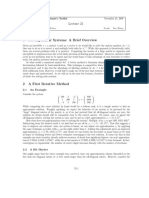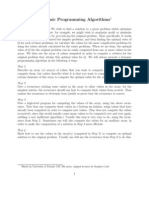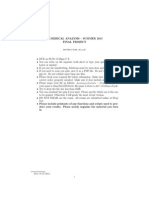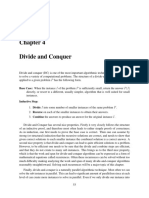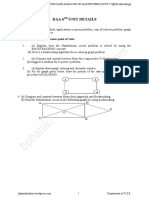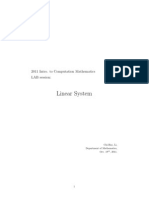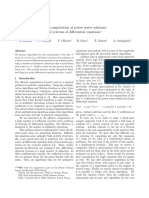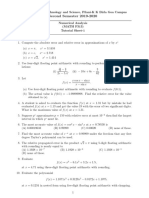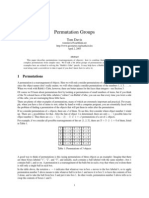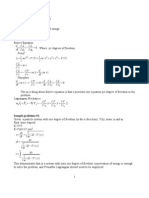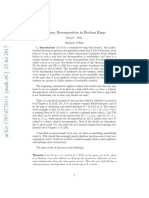0 ratings0% found this document useful (0 votes)
206 viewsMatrix Chain Multiplication
Matrix Chain Multiplication
Uploaded by
amukhopadhyayThe document discusses the matrix chain multiplication problem, which involves determining the optimal order of operations for multiplying a sequence of matrices. It can be solved using dynamic programming by breaking the problem down into optimal subproblems. The dynamic programming approach involves defining a recursive formula to calculate the minimum number of scalar multiplications needed to compute matrix chains of different lengths, and populating a table in a bottom-up manner to determine the optimal solution.
Copyright:
© All Rights Reserved
Available Formats
Download as DOCX, PDF, TXT or read online from Scribd
Matrix Chain Multiplication
Matrix Chain Multiplication
Uploaded by
amukhopadhyay0 ratings0% found this document useful (0 votes)
206 views11 pagesThe document discusses the matrix chain multiplication problem, which involves determining the optimal order of operations for multiplying a sequence of matrices. It can be solved using dynamic programming by breaking the problem down into optimal subproblems. The dynamic programming approach involves defining a recursive formula to calculate the minimum number of scalar multiplications needed to compute matrix chains of different lengths, and populating a table in a bottom-up manner to determine the optimal solution.
Original Description:
Matrix Chain Multiplication with complexity
Copyright
© © All Rights Reserved
Available Formats
DOCX, PDF, TXT or read online from Scribd
Share this document
Did you find this document useful?
Is this content inappropriate?
The document discusses the matrix chain multiplication problem, which involves determining the optimal order of operations for multiplying a sequence of matrices. It can be solved using dynamic programming by breaking the problem down into optimal subproblems. The dynamic programming approach involves defining a recursive formula to calculate the minimum number of scalar multiplications needed to compute matrix chains of different lengths, and populating a table in a bottom-up manner to determine the optimal solution.
Copyright:
© All Rights Reserved
Available Formats
Download as DOCX, PDF, TXT or read online from Scribd
Download as docx, pdf, or txt
0 ratings0% found this document useful (0 votes)
206 views11 pagesMatrix Chain Multiplication
Matrix Chain Multiplication
Uploaded by
amukhopadhyayThe document discusses the matrix chain multiplication problem, which involves determining the optimal order of operations for multiplying a sequence of matrices. It can be solved using dynamic programming by breaking the problem down into optimal subproblems. The dynamic programming approach involves defining a recursive formula to calculate the minimum number of scalar multiplications needed to compute matrix chains of different lengths, and populating a table in a bottom-up manner to determine the optimal solution.
Copyright:
© All Rights Reserved
Available Formats
Download as DOCX, PDF, TXT or read online from Scribd
Download as docx, pdf, or txt
You are on page 1of 11
Matrix-chain Multiplication Problem
The chain matrix multiplication problem is perhaps the most
popular example of dynamic programming used in the upper
undergraduate course (or review basic issues of dynamic
programming in advanced algorithm's class).
The chain matrix multiplication problem involves the question
of determining the optimal sequence for performing a series
of operations. This general class of problem is important in
complier design for code optimization and in databases for
query optimization. We will study the problem in a very
restricted instance, where the dynamic programming issues
are clear. Suppose that our problem is to multiply a chain
of n matrices A
1
A
2
... A
n
. Recall (from your discrete structures
course), matrix multiplication is an associative but not a
commutative operation. This means that you are free to
parenthesize the above multiplication however we like, but we
are not free to rearrange the order of the matrices. Also, recall
that when two (non-square) matrices are being multiplied,
there are restrictions on the dimensions.
Suppose, matrix A has p rows and q columns i.e., the
dimension of matrix A is p q. You can multiply a
matrix A of p q dimensions times a matrix B of
dimensions q r, and the result will be a matrix C with
dimensions p r. That is, you can multiply two matrices if
they are compatible: the number of columns of A must equal
the number of rows of B.
In particular, for 1 i p and 1 j r, we have
C[i, j] =
1 k q
A[i, k] B[k, j].
There are p . r total entries in C and each takes O(q) time to
compute, thus the total time to multiply these two matrices is
dominated by the number of scalar multiplication, which
is p .q . r.
Problem Formulation
Note that although we can use any legal parenthesization,
which will lead to a valid result. But, not all parenthesizations
involve the same number of operations. To understand this
point, consider the problem of a chain A
1
, A
2
, A
3
of three
matrices and suppose
A
1
be of dimension 10 100
A
2
be of dimension 100 5
A
3
be of dimension 5 50
Then,
MultCost[((A
1
A
2
) A
3
)] = (10 . 100 . 5) + (10 . 5 . 50)
= 7,500 scalar multiplications.
MultCost[(A
1
(A
2
A
3
))] = (100 . 5 . 50) + (10 . 100 .
50) = 75,000 scalar multiplications.
It is easy to see that even for this small example, computing
the product according to first parenthesization is 10 times
faster.
The Chain Matrix Multiplication Problem
Given a sequence of n matrices A
1
, A
2
, ... A
n
, and their
dimensions p
0
, p
1
, p
2
, ..., p
n
, where where i = 1, 2, ..., n,
matrix A
i
has dimension p
i 1
p
i
, determine the order of
multiplication that minimizes the the number of scalar
multiplications.
Equivalent formulation (perhaps more easy to work
with!)
Given n matrices, A
1
, A
2
, ... A
n
, where for 1 i n, A
i
is a p
i
1
p
i
, matrix, parenthesize the product A
1
, A
2
, ... A
n
so as to
minimize the total cost, assuming that the cost of multiplying
an p
i 1
p
i
matrix by a p
i
p
i + 1
matrix using the naive
algorithm is p
i 1
p
i
p
i + 1
.
Note that this algorithm does not perform the multiplications,
it just figures out the best order in which to perform the
multiplication operations.
Naive Algorithm
Well, lets start from the obvious! Suppose we are given a list
of n matrices. lets attack the problem with brute-force and try
all possible parenthesizations. It is easy to see that the number
of ways of parenthesizing an expression is very large. For
instance, if you have just one item in the list, then there is
only one way to parenthesize. Similarly, if you have n item in
the list, then there are n 1 places where you could split the
list with the outermost pair of parentheses, namely just after
first item, just after the second item, and so on and so forth,
and just after the (n 1)
th
item in the list.
On the other hand, when we split the given list just after
the k
th
item, we create two sublists to be parenthesized, one
with k items, and the other with n k items. After splitting,
we could consider all the ways of parenthesizing these sublists
(brute force in action). If there are L ways to parenthesize the
left sublist and R ways to parenthesize the right sublist and
since these are independent choices, then the total is
L times R. This suggests the following recurrence for P(n), the
number of different ways of parenthesizing n items:
This recurrence is related to a famous function in
combinatorics called the Catalan numbers, which in turn is
related to the number of different binary trees on n nodes. The
solution to this recurrence is the sequence of Catalan numbers.
In particular P(n) = C(n 1), where C(n) is the n
th
Catalan
number. And, by applying Stirling's formula, we get the lower
bound on the sequence. That is,
since 4
n
is exponential and n
3/2
is just a polynomial, the
exponential will dominate the expression, implying that
function grows very fast. Thus, the number of solutions is
exponential inn, and the brute-force method of exhaustive
search is a poor strategy for determining the optimal
parenthesization of a matrix chain. Therefore, the naive
algorithm will not be practical except for very small n.
Dynamic Programming Approach
The first step of the dynamic programming paradigm is to
characterize the structure of an optimal solution. For the chain
matrix problem, like other dynamic programming problems,
involves determining the optimal structure (in this case, a
parenthesization). We would like to break the problem into
subproblems, whose solutions can be combined to obtain a
solution to the global problem.
For convenience, let us adopt the notation A
i .. j
, where i j, for
the result from evaluating the product A
i
A
i + 1
... A
j
. That is,
A
i .. j
A
i
A
i + 1
... A
j
, where i j,
It is easy to see that is a matrix A
i .. j
is of dimensions p
i
p
i
+ 1
.
In parenthesizing the expression, we can consider the highest
level of parenthesization. At this level we are simply
multiplying two matrices together. That is, for any k, 1
k n 1,
A
1..n
= A
1..k
A
k+1..n
.
Therefore, the problem of determining the optimal sequence
of multiplications is broken up into two questions:
Question 1: How do we decide where to split the
chain? (What is k?)
Question 2: How do we parenthesize the
subchains A
1..k
A
k+1..n
?
The subchain problems can be solved by recursively applying
the same scheme. On the other hand, to determine the best
value of k, we will consider all possible values of k, and pick
the best of them. Notice that this problem satisfies the
principle of optimality, because once we decide to break the
sequence into the product , we should compute each
subsequence optimally. That is, for the global problem to be
solved optimally, the subproblems must be solved optimally
as well.
The key observation is that the parenthesization of the
"prefix" subchain A
1..k
within this optimal parenthesization
of A
1..n
. must be an optimal parenthesization of A
1..k
.
Dynamic Programming Formulation
The second step of the dynamic programming paradigm is to
define the value of an optimal solution recursively in terms of
the optimal solutions to subproblems. To help us keep track of
solutions to subproblems, we will use a table, and build the
table in a bottomup manner. For 1 i j n, let m[i, j] be the
minimum number of scalar multiplications needed to compute
the A
i..j
. The optimum cost can be described by the following
recursive formulation.
Basis: Observe that if i = j then the problem is trivial; the
sequence contains only one matrix, and so the cost is 0. (In
other words, there is nothing to multiply.) Thus,
m[i, i] = 0 for i = 1, 2, ..., n.
Step: If i j, then we are asking about the product of the
subchain A
i..j
and we take advantage of the structure of an
optimal solution. We assume that the optimal parenthesization
splits the product, A
i..j
into for each value of k, 1 k n 1
as A
i..k
. A
k+1..j
.
The optimum time to compute is m[i, k], and the optimum
time to compute is m[k + 1, j]. We may assume that these
values have been computed previously and stored in our array.
Since A
i..k
is a matrix, and A
k+1..j
is a matrix, the time to
multiply them is p
i 1
. p
k
. p
j
. This suggests the following
recursive rule for computing m[i, j].
To keep track of optimal subsolutions, we store the value
of k in a table s[i, j]. Recall, k is the place at which we split
the product A
i..j
to get an optimal parenthesization. That is,
s[i, j] = k such that m[i, j] = m[i, k] + m[k + 1, j] + p
i 1
. p
k
. p
j
.
Implementing the Rule
The third step of the dynamic programming paradigm is to
construct the value of an optimal solution in a bottom-up
fashion. It is pretty straight forward to translate the above
recurrence into a procedure. As we have remarked in the
introduction that the dynamic programming is nothing but the
fancy name for divide-and-conquer with a table. But here in
dynamic programming, as opposed to divide-and-conquer, we
solve subproblems sequentially. It means the trick here is to
solve them in the right order so that whenever the solution to a
subproblem is needed, it is already available in the table.
Consequently, in our problem the only tricky part is arranging
the order in which to compute the values (so that it is readily
available when we need it). In the process of computing m[i,j]
we will need to access values m[i, k] and m[k + 1, j] for each
value of k lying between i and j. This suggests that we should
organize our computation according to the number of matrices
in the subchain. So, lets work on the subchain:
Let L = j i + 1 denote the length of the subchain being
multiplied. The subchains of length 1 (m[i, i]) are trivial. Then
we build up by computing the subchains of length 2, 3, ..., n.
The final answer is m[1, n].
Now set up the loop: Observe that if a subchain of length L
starts at position i, then j = i + L 1. Since, we would like to
keep j in bounds, this means we want j n, this, in turn,
means that we want i + L 1 n, actually what we are saying
here is that we want i n L +1. This gives us the closed
interval for i. So our loop for i runs from 1 to n L + 1.
Matrix-Chain(array p[1 .. n], int n) {
Array s[1 .. n 1, 2 .. n];
FOR i =1 TO n
DO m[i, i]=0; //
initialize
FOR L=2 TO n DO {
// L=length of subchain
FOR i = 1 TO n L + 1 do {
j = i + L 1;
m[i, j] = infinity;
FOR k = i TO j 1 DO {
// check all splits
q = m[i, k] + m[k + 1, j] + p[i 1] p[k] p[j];
IF (q < m[i, j]) {
m[i, j] = q;
s[i, j] = k;
}
}
}
}
return m[1, n](final cost) and s (splitting
markers);
}
Example [on page 337 in CLRS]: The m-table computed by
MatrixChain procedure for n = 6
matrices A
1
, A
2
, A
3
, A
4
, A
5
, A
6
and their dimensions 30, 35, 15,
5, 10, 20, 25.
Note that the m-table is rotated so that the main diagonal runs
horizontally. Only the main diagonal and upper triangle is
used.
Constructing an optimal solution
Complexity Analysis
Clearly, the space complexity of this procedure (n
2
). Since
the tables m and s require (n
2
) space. As far as the time
complexity is concern, a simple inspection of the for-loop(s)
structures gives us a running time of the procedure. Since, the
three for-loops are nested three deep, and each one of them
iterates at most n times (that is to say indices L, i, and j takes
on at most n 1 values). Therefore, The running time of this
procedure is (n
3
).
You might also like
- Matrix Chain MultiplicationDocument4 pagesMatrix Chain MultiplicationjoycyNo ratings yet
- DAA (Unit 2)Document88 pagesDAA (Unit 2)aanandram221No ratings yet
- Lec3 PDFDocument9 pagesLec3 PDFyacp16761No ratings yet
- SortingDocument57 pagesSortingSanjeeb PradhanNo ratings yet
- Aad 4Document19 pagesAad 4tobymanpurayidathilmathew.b22cs1159No ratings yet
- Solu 3Document28 pagesSolu 3Aswani Kumar100% (2)
- Design Techniques Part 2 64Document15 pagesDesign Techniques Part 2 64SANDEEP SinghNo ratings yet
- Big OhDocument10 pagesBig OhFrancesHsiehNo ratings yet
- ADA QB SolDocument13 pagesADA QB Solankitaarya1207No ratings yet
- U5 (1) (2)Document16 pagesU5 (1) (2)sreenidhiborntoruletheworldNo ratings yet
- 20MCA023 Algorithm AssighnmentDocument13 pages20MCA023 Algorithm AssighnmentPratik KakaniNo ratings yet
- Assignment 1 - GossipDocument3 pagesAssignment 1 - GossipAgustín EstramilNo ratings yet
- Assign5 SolutionDocument4 pagesAssign5 SolutionKiet NguyenNo ratings yet
- 03a1 MIT18 - 409F09 - Scribe21Document8 pages03a1 MIT18 - 409F09 - Scribe21Omar Leon IñiguezNo ratings yet
- A Minimal Algorithm For The Multiple-Choice Knapsack ProblemDocument23 pagesA Minimal Algorithm For The Multiple-Choice Knapsack ProblemsulphuckeriumNo ratings yet
- Daa Kcs503 2021-22 Aktu Qpaper SolDocument40 pagesDaa Kcs503 2021-22 Aktu Qpaper SolMRIGYA SAHAINo ratings yet
- Practice Sheet Divide and ConquerDocument5 pagesPractice Sheet Divide and ConquerApoorva GuptaNo ratings yet
- Design & Analysis of Algorithms: Bits, Pilani - K. K. Birla Goa CampusDocument27 pagesDesign & Analysis of Algorithms: Bits, Pilani - K. K. Birla Goa CampusSohan MisraNo ratings yet
- Math 243M, Numerical Linear Algebra Lecture NotesDocument71 pagesMath 243M, Numerical Linear Algebra Lecture NotesRonaldNo ratings yet
- Blaeser Algorithms and Data StructuresDocument109 pagesBlaeser Algorithms and Data StructuresMaia OsadzeNo ratings yet
- MidsemDocument6 pagesMidsemAravind SomasundaramNo ratings yet
- DynprogDocument18 pagesDynprogHykinel Bon GuarteNo ratings yet
- Unit 5Document16 pagesUnit 5Nimmati Satheesh KannanNo ratings yet
- What Are Stacks and QueuesDocument13 pagesWhat Are Stacks and QueuesrizawanshaikhNo ratings yet
- Exercises of Design & AnalysisDocument7 pagesExercises of Design & AnalysisAndyTrinh100% (1)
- MAE 200A - Homework Set #1Document2 pagesMAE 200A - Homework Set #1vsauerNo ratings yet
- DAA Unit 5Document14 pagesDAA Unit 5hari karanNo ratings yet
- Final 13Document9 pagesFinal 13نورالدين بوجناحNo ratings yet
- Introduction To Dynamic Programming: 20bits About WritingDocument6 pagesIntroduction To Dynamic Programming: 20bits About WritingAyele MitkuNo ratings yet
- Iterative Matrix ComputationDocument55 pagesIterative Matrix Computationnicomh2No ratings yet
- Lab 1Document11 pagesLab 1RanaAshNo ratings yet
- To Print - Dynprog2Document46 pagesTo Print - Dynprog2sourish.js2021No ratings yet
- Notes On Dynamic Programming Algorithms & Data Structures: DR Mary CryanDocument12 pagesNotes On Dynamic Programming Algorithms & Data Structures: DR Mary Cryanapi-264609281No ratings yet
- Module-2:Divide and ConquerDocument26 pagesModule-2:Divide and ConquerSk ShettyNo ratings yet
- Multiplym 2Document23 pagesMultiplym 2adyant.gupta2022No ratings yet
- Defcon 18 Schearer ShodanDocument27 pagesDefcon 18 Schearer ShodanYvanNo ratings yet
- Module 2 Daa FINAL 20201Document29 pagesModule 2 Daa FINAL 20201trichy_sathishNo ratings yet
- NP-hard Problems and Approximation Algorithms: 10.1 What Is The Class NP?Document29 pagesNP-hard Problems and Approximation Algorithms: 10.1 What Is The Class NP?Aleksandr TerranovaNo ratings yet
- BCS401 ADA m2 NotesDocument28 pagesBCS401 ADA m2 Notessantoshpatilrao33No ratings yet
- Conjugate Gradient MethodDocument8 pagesConjugate Gradient MethodDavid HumeNo ratings yet
- NA FinalExam Summer15 PDFDocument8 pagesNA FinalExam Summer15 PDFAnonymous jITO0qQHNo ratings yet
- Divide and ConquerDocument20 pagesDivide and ConquerVinay MishraNo ratings yet
- Notes On Divide-and-Conquer and Dynamic Programming.: 1 N 1 n/2 n/2 +1 NDocument11 pagesNotes On Divide-and-Conquer and Dynamic Programming.: 1 N 1 n/2 n/2 +1 NMrunal RuikarNo ratings yet
- Mcs 031 qns2 Image: Travelling Salesman Problem Previous PostDocument5 pagesMcs 031 qns2 Image: Travelling Salesman Problem Previous PostUmesh sharmaNo ratings yet
- Exercises of Design & AnalysisDocument6 pagesExercises of Design & AnalysisKhang NguyễnNo ratings yet
- Daa Unit Vi NotesDocument15 pagesDaa Unit Vi NotesPoorvaNo ratings yet
- ps2Document3 pagesps2sunshiyao0No ratings yet
- Lec12.1-Dynamic Programming 2Document32 pagesLec12.1-Dynamic Programming 2marah qadiNo ratings yet
- MIR2012 Lec1Document37 pagesMIR2012 Lec1yeesuenNo ratings yet
- Linear System: 2011 Intro. To Computation Mathematics LAB SessionDocument7 pagesLinear System: 2011 Intro. To Computation Mathematics LAB Session陳仁豪No ratings yet
- Bosco en El Articulo MatematicoDocument10 pagesBosco en El Articulo MatematicoartovolastiNo ratings yet
- Final Exam: 1. Lots of Ones (20 Points)Document4 pagesFinal Exam: 1. Lots of Ones (20 Points)FidaHussainNo ratings yet
- Tut2 QuestionsDocument3 pagesTut2 QuestionsAmir SharifiNo ratings yet
- To Read Dynprog2Document50 pagesTo Read Dynprog2sourish.js2021No ratings yet
- hw09 Solution PDFDocument8 pageshw09 Solution PDFsiddharth1kNo ratings yet
- PresDocument18 pagesPresEr Umesh ThoriyaNo ratings yet
- Divide and Conquer: Analysis of AlgorithmsDocument11 pagesDivide and Conquer: Analysis of Algorithmsgashaw asmamawNo ratings yet
- Daaunit IVDocument17 pagesDaaunit IVHarika KopparthiNo ratings yet
- MCQ XMLDocument5 pagesMCQ XMLamukhopadhyayNo ratings yet
- 2nd ClassDocument7 pages2nd ClassamukhopadhyayNo ratings yet
- String MatchingDocument12 pagesString MatchingamukhopadhyayNo ratings yet
- StrassenDocument8 pagesStrassenamukhopadhyayNo ratings yet
- Graph Traversal Algorithm: RecapitulationDocument14 pagesGraph Traversal Algorithm: RecapitulationamukhopadhyayNo ratings yet
- Recurrence TreeDocument6 pagesRecurrence TreeamukhopadhyayNo ratings yet
- Networking BasicsDocument14 pagesNetworking BasicsamukhopadhyayNo ratings yet
- ARQDocument6 pagesARQamukhopadhyayNo ratings yet
- Substitution MethodDocument6 pagesSubstitution MethodamukhopadhyayNo ratings yet
- Myhill NerodeDocument10 pagesMyhill NerodeamukhopadhyayNo ratings yet
- AutoDocument7 pagesAutoamukhopadhyayNo ratings yet
- Transport Layer Notes Module 3Document10 pagesTransport Layer Notes Module 3amukhopadhyayNo ratings yet
- Calibration Problem Minimum No of Control PointsDocument1 pageCalibration Problem Minimum No of Control PointsamukhopadhyayNo ratings yet
- Disjoint SetDocument4 pagesDisjoint SetamukhopadhyayNo ratings yet
- Pumping Lemma Note - Get - EasyDocument3 pagesPumping Lemma Note - Get - EasyamukhopadhyayNo ratings yet
- Phase 1: Requirement Analysis and Specification. The Main Task of This Phase Is ToDocument19 pagesPhase 1: Requirement Analysis and Specification. The Main Task of This Phase Is ToamukhopadhyayNo ratings yet
- Advanced C Concepts: 2501ICT NathanDocument32 pagesAdvanced C Concepts: 2501ICT NathanamukhopadhyayNo ratings yet
- 4 Reg ExDocument26 pages4 Reg ExasinawahabNo ratings yet
- Choto DidiDocument1 pageChoto DidiamukhopadhyayNo ratings yet
- 3 PipelineDocument21 pages3 PipelineamukhopadhyayNo ratings yet
- Exercise 13 & 16 Creative Question: General MathematicsDocument2 pagesExercise 13 & 16 Creative Question: General MathematicsArnabNo ratings yet
- All Problems and AnswersDocument31 pagesAll Problems and AnswerstarhuniNo ratings yet
- DLL - Mathematics 6 - Q3 - W6Document7 pagesDLL - Mathematics 6 - Q3 - W6Treshiel JohnwesleyNo ratings yet
- New Green Field School Alaknanda: Syllabus Class XI - Science Session 2024-25Document11 pagesNew Green Field School Alaknanda: Syllabus Class XI - Science Session 2024-25Anamika JaswalNo ratings yet
- Second Semester 2019-2020Document2 pagesSecond Semester 2019-2020Abhigyan ShekharNo ratings yet
- Unit 5.2 Multiple Choice Practice Parallel and PerpendicularDocument4 pagesUnit 5.2 Multiple Choice Practice Parallel and PerpendicularmahatharwatNo ratings yet
- SamplePaper-XII-Microsoft Word - MCQ 12 Main Maths-133478021686146922Document6 pagesSamplePaper-XII-Microsoft Word - MCQ 12 Main Maths-133478021686146922devblogger40No ratings yet
- Fairing Methods of Planar and Space Curves Under Design Constraints - Applications in Computer-Aided Ship DesignDocument124 pagesFairing Methods of Planar and Space Curves Under Design Constraints - Applications in Computer-Aided Ship DesignKostis PigounakisNo ratings yet
- m2l6 PDFDocument6 pagesm2l6 PDFsrinadh1602No ratings yet
- Numerical Solutions in Heat TransferDocument14 pagesNumerical Solutions in Heat Transferaranna lalNo ratings yet
- Mathematics Paper 3 Sets Relations and Groups HL MarkschemeDocument10 pagesMathematics Paper 3 Sets Relations and Groups HL MarkschemeNeelamNo ratings yet
- Enggmath 2 Midterm ExamDocument2 pagesEnggmath 2 Midterm ExamAyaNo ratings yet
- Algebra Questions For CATDocument12 pagesAlgebra Questions For CATAnsh LohiaNo ratings yet
- Spline InterpolationDocument8 pagesSpline Interpolationrod8silvaNo ratings yet
- A Note On Riemann Normal Coordinates.Document6 pagesA Note On Riemann Normal Coordinates.hammoudeh13No ratings yet
- S&NMDocument2 pagesS&NMManoji PNo ratings yet
- Differential Equation - Examples of Exact EquationsDocument4 pagesDifferential Equation - Examples of Exact EquationsAimi Najwa Zailan50% (2)
- Finding Domain and Range of A Function G8 1Document13 pagesFinding Domain and Range of A Function G8 1kennethvilla07No ratings yet
- Rational NumbersDocument5 pagesRational NumbersMichael Lumogda Dela PeñaNo ratings yet
- Lecture 15 - The Lie Group SL (2, C) and Its Lie Algebra SL (2, C) (Schuller's Geometric Anatomy of Theoretical Physics)Document10 pagesLecture 15 - The Lie Group SL (2, C) and Its Lie Algebra SL (2, C) (Schuller's Geometric Anatomy of Theoretical Physics)Simon ReaNo ratings yet
- Permutation GroupsDocument12 pagesPermutation GroupsHimanshu AhujaNo ratings yet
- 2D and 3D TransformationDocument42 pages2D and 3D Transformationachintya0105No ratings yet
- PH36010 Numerical Methods: Solving Differential Equations Using MATHCADDocument32 pagesPH36010 Numerical Methods: Solving Differential Equations Using MATHCADbashasvuceNo ratings yet
- 11-Tangents To CirclesDocument4 pages11-Tangents To CirclesCorbette AlvaroNo ratings yet
- JACOBIANDocument14 pagesJACOBIANŞįśirŚärķeŕNo ratings yet
- Classical Mechanics NotesDocument54 pagesClassical Mechanics NotesAmichai LevyNo ratings yet
- Math 201 Lecture 12: Cauchy-Euler EquationsDocument8 pagesMath 201 Lecture 12: Cauchy-Euler EquationsPlease ScribdNo ratings yet
- Mat112n2017 PDFDocument4 pagesMat112n2017 PDFThemba MdlaloseNo ratings yet
- Primary Decomposition in Boolean Rings: X X X X X X X yDocument11 pagesPrimary Decomposition in Boolean Rings: X X X X X X X yrizkyNo ratings yet
- 2015 1 Ked Mahsuri (Q)Document3 pages2015 1 Ked Mahsuri (Q)Misteri JongNo ratings yet













